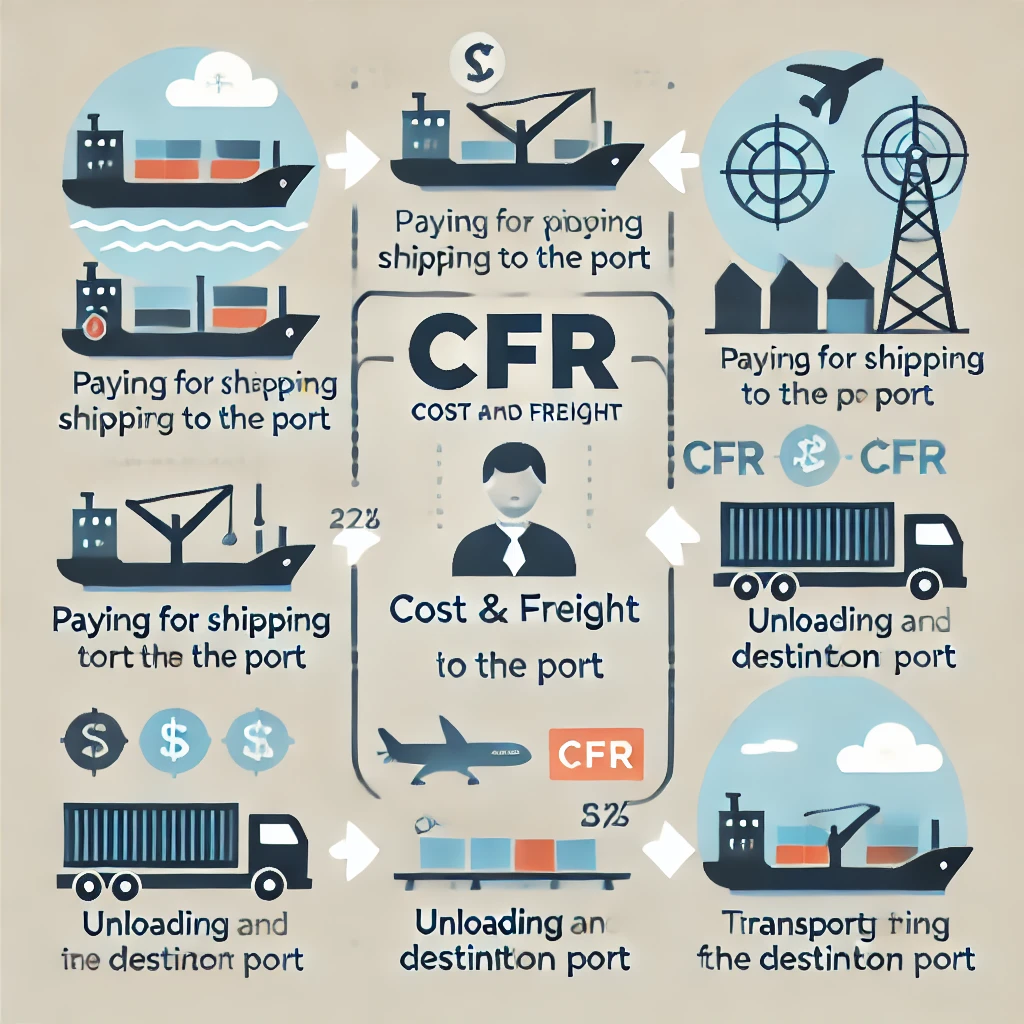The Basics of CFR Meaning

What is CFR (Cost and Freight)?
CFR stands for Cost and Freight, which is an Incoterm that describes the responsibilities of the seller and buyer when shipping goods internationally. Under CFR, the seller is responsible for covering the costs and arranging the transportation of goods to the destination port. However, once the goods arrive at the destination port, the buyer assumes responsibility for all risks, including any potential damage during transit and the cost of unloading.
It’s important to note that CFR only applies to sea and inland waterway transportation. Therefore, it is not suitable for air or land transport.

Key Features of CFR
- Seller’s Responsibilities:
- Under CFR, the seller is responsible for delivering the goods to a port of shipment and covering all costs related to transporting the goods to the destination port. This includes:
- Paying for the shipping fees.
- Arranging for loading the goods onto the vessel.
- Providing the necessary documents to facilitate export customs clearance.
- Arranging for the goods to be transported to the destination port.
- Under CFR, the seller is responsible for delivering the goods to a port of shipment and covering all costs related to transporting the goods to the destination port. This includes:
- Buyer’s Responsibilities:
- Once the goods reach the destination port, the buyer assumes full responsibility. This includes:
- Paying for unloading charges.
- Managing import customs clearance and payment of duties.
- Taking responsibility for transportation from the destination port to the final destination.
- Bearing the risk of loss or damage after the goods are delivered to the port of destination.
- Once the goods reach the destination port, the buyer assumes full responsibility. This includes:
- Risk Transfer:
- While the seller arranges for and pays for the transportation to the destination port, the risk of loss or damage to goods is transferred to the buyer as soon as the goods are loaded onto the vessel at the port of departure.
- Freight Charges:
- The seller covers the cost of shipping the goods, but the buyer pays for all other associated charges once the goods reach the destination port, including unloading, customs, and further transportation costs.
Practical Uses of CFR
- International Shipping:
- CFR is commonly used in sea freight shipments where the seller is responsible for the cost and arrangement of transport but the buyer assumes the risk once the goods are loaded onto the vessel. It’s ideal for businesses looking to control shipping arrangements but shift the risks and other costs to the buyer.
- When the Buyer Handles the Final Leg of Delivery:
- CFR is a good option when the buyer has better control over the transportation or logistics operations in their own country. For example, if the buyer has a reliable and cost-effective local transportation network for transporting goods from the port to the final destination.
- Supplier-Side Responsibility:
- Sellers who are responsible for managing freight, but who want to avoid assuming responsibility for unloading and local transportation at the destination port, find CFR useful. It allows them to organize and manage the shipping process but pass on the final delivery obligations to the buyer.

Relevance of CFR for Professionals and Businesses
- Cost Control for Sellers:
- CFR allows sellers to control the major shipping costs until the goods reach the destination port. Sellers can manage the freight process, ensuring that the shipment arrives on time, but they are not liable for additional costs at the destination port.
- Clear Distribution of Responsibilities:
- CFR clearly outlines the seller and buyer responsibilities, making it easier to identify who is liable for which aspects of the shipping process. This helps to prevent misunderstandings or disputes during the shipping process.
- Simplified Logistics for Buyers:
- Buyers can benefit from CFR if they prefer to handle the importation process and further transportation from the port to their location. This gives them more control over the final leg of the shipping journey.
- Global Trade Compliance:
- As CFR is an internationally recognized Incoterm, using it helps businesses comply with global trade standards and practices. It ensures a standardized approach to shipping and logistics that can be crucial for international business operations.

Advantages and Disadvantages of CFR
Advantages for Sellers:
- Control over the transportation process up to the destination port.
- Lower risk exposure once the goods are on board the ship.
- Clear cost structure for shipping arrangements.
Advantages for Buyers:
- Control over unloading, customs clearance, and further transportation.
- No obligation to pay for international shipping costs.
- Flexibility in handling local delivery methods and cost management.
Disadvantages for Sellers:
- Limited control over what happens once the goods arrive at the destination port.
- Potential for disputes regarding the condition of the goods when they arrive.
Disadvantages for Buyers:
- Risk is transferred to the buyer once goods are loaded onto the vessel, making them responsible for any damage or loss during transit.
- Buyers must manage their local logistics and customs clearance.
Conclusion
CFR (Cost and Freight) is an important Incoterm in the international shipping industry that provides a clear division of responsibility between the seller and buyer. By using CFR, sellers can manage shipping costs up to the destination port, while buyers assume responsibility for unloading and local transport. Understanding CFR helps businesses navigate international logistics more effectively, ensuring that goods are delivered in a controlled, efficient manner while clarifying the roles and responsibilities of both parties involved.
